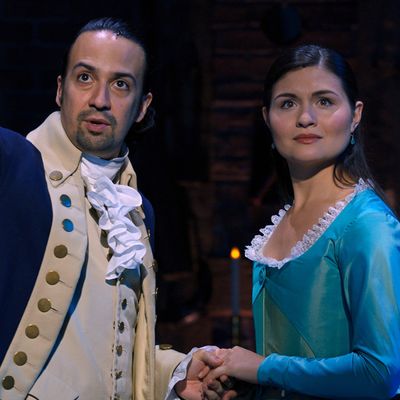
As the characters in Hamilton often reiterate, living your life is one thing, how it ends up in history is another. But when a stage show gets filmed and becomes a movie, the questions of who lives, who dies, etc. boil down pretty much to decisions made in the editing room. In the case of Hamilton, those decisions fell mostly to Thomas Kail, who also directed the stage show, and editor Jonah Moran (the two worked together on Fosse/Verdon.) They put together footage from Sunday matinee and Tuesday night performances by the original cast in 2016, plus close-ups from 13 of the numbers in the show shot on the Monday between those performances, into a two-hour-and-40-minute recreation of the show with the guiding principle, according to Kail, that the film “embrace that we’re in the theater, and celebrate that we’re in the theater.”
The resulting cut of Hamilton, as Vulture’s Mark Harris put it, makes for something that is “is in-your-face at a moment when nothing is allowed to be in your face,” moving between wide shots that emphasize the show’s staging and close-ups that capture the deep expression and exertion on performers’ faces. Moran and Kail talked us through the roughly four-year process of putting together the film.
Editing like you’re not running out of time
The film, produced by RadicalMedia, taped their footage in June 2016, just before Lin-Manuel Miranda and most of the original cast left the show, but they didn’t have a set plan for a release date at the time, which meant that there was plenty of space for editing. “One of the things that was nice about making this film independently is we didn’t have any deadlines,” Kail said. He and Moran met in August of that year to discuss the project. Moran signed up to do it, went to see the show to help map out what beats would make the most sense to emphasize, and started to assemble a rough cut from the footage, showing Miranda a version of the first act by early 2017.
From there, Kail and Moran worked in the editing room on and off as they moved between various other obligations, arriving at what Kail felt was a “fine” cut of the whole show by the beginning of 2018. That’s the version they shopped around Hollywood, and eventually sold to Disney. Then, in February of 2020, just before quarantine started, Kail and Moran started to look over the footage again, just before Disney decided to accelerate the film’s release in the midst of the pandemic. “We did the last bits remotely,” Kail said.
Setting the stage, in a very theatrical way
Among the last touches they applied in early 2020, Kail and Moran decided to increase the feeling of being at a stage show when you watch the movie by changing up the movie’s intro, adding in sound from the Richard Rodgers Theatre audience over the Disney logo, and including Jonathan Groff’s speech as King George III asking audience members to turn off their phones. “Having that in was an important part of saying, ‘This is the theater, we’re watching what happened on these nights,’” Moran said. The stage lights fade in just as the king announces that “video recording is strictly prohibited,” to wink at the fact that, in this case, video recording very much was happening.
Working the camera angles
Continuing into the show’s opening number, “Alexander Hamilton,” Kail felt it was important to establish the “grammar” of how the film was shot. To tape the movie, cinematographer Declan Quinn placed nine cameras around the theater, with some hidden overhead and onstage, for the performances with an audience, and then used a Steadicam to capture the close-up footage between shows. Kail wanted to use the opening number to “set up a language and vocabulary that could be continued” throughout the film. That meant sticking to the wider shots as the characters start to introduce the plot, and then cutting to the precious Steadicam footage only at the right moment for dramatic effect. In this case, right when Miranda enters the story.
“You want to save your close-up features for Alexander Hamilton and Burr, those are the two characters that have Steadicam treatment in that first number,” Moran said. “You want the Steadicam to be communicating something, and not used gratuitously, because otherwise you become inoculated to its power.”
Making a satisfactory “rewind”
In making a film out of a stage musical like Hamilton, Kail and Moran knew that any close-up by necessity would also cut out a lot of the rest of the ensemble from the frame. Kail and Moran felt it was important to convey Andy Blankenbuehler’s choreography. “So much of our show is told with the physical language of our ensemble,” Kail said. To that end, you can often track the movement of the ensemble behind the primary characters in wide shots, and even the action that occurs with characters on the surround, the upper balcony onstage. “There’s always characters up there doing something that’s at least subconsciously significant to the story,” Moran said.
But there are a few staging gestures that were especially challenging to reinterpret on film, among them the “rewind” that occurs at the beginning of “Satisfied,” in which Angelica Schuyler (Renée Elise Goldsberry) flashes back to her side of Hamilton and her sister’s courtship. “Andy’s choreography works in the vernacular of film, a lot of times he’ll use slo-mo or rewinding actions,” Moran said. “So you’re like, How do we translate this back from what is created as a tableau onstage, back to cinema?” For that moment, instead of staying in a wide shot, Kail and Moran decided to metaphorically “go into her head” and introduce a lot of quick cuts as time skips backward. “It felt like a chance for us, in this different medium, to say that something’s about to happen, to go inside of her brain” Kail said. “I remember Jonah saying, ‘Does this feel right?’ And it instinctively did. Other people might feel differently, but it was an opportunity to change the cadence of what we were doing.”
Capturing the blood, sweat, and spit
Further emphasizing the fact that you’re watching a live taping of a stage show, the film’s close-ups give you a sense of the cast’s physical exertion throughout the show, whether in the form of sweat coming off their bodies, or, in Jonathan Groff’s case, very visible spit. Making sure that you see that aspect of the work was important to Kail and Moran. “You want to see what the physical cost is at that moment in the show, that’s part of the artistry” Kail said. “And I might be misremembering it, but that’s probably the least I’ve seen Jonathan Groff spit.”
Giving up two “fucks”
In another form of editing, this time for language, Miranda and Kail agreed to elide two “fucks” from the show in order to get it to a PG-13 rating, which means that audiences miss out on a “fuck” in “Yorktown” from Hercules Mulligan, and get a record scratch over “motherfuckin’ Democratic Republicans” in “Washington on Your Side.” To Kail, the “Yorktown” cut made sense, because “the way we shot ‘Yorktown,’ Oak [Onaodowan, who plays Mulligan] jumps out of frame, so it felt like that being dipped to zero connected to the picture.” The record scratch in “Washington on Your Side,” on the other hand, fit with the rhythm of the song, and felt like it could just be a reference to bleeping a word on the radio. The “fuck” that remains, in “Say No to This,” needed to stay, in a large part because it is a joke. “It gets a laugh,” Kail said, “to not have anything there would be a strange moment.”
Closing with a gasp
Those who only knew Hamilton through its cast recording before watching the Disney+ version might be surprised to discover a moment at the end of the show that you could only witness onstage. At the end of the last song, “Who Lives, Who Dies, Who Tells Your Story,” Eliza (Phillipa Soo) describes her work preserving Hamilton’s legacy, and then Hamilton (or perhaps, Miranda as himself) takes her hand, walks her to the front of the stage, and she looks up and gasps. That gasp came out of conversations Soo, Miranda, and Kail had in rehearsal about how to end the show, and intentionally has different interpretations depending on the night and the actor playing Eliza. It could be Eliza’s own death, her seeing Hamilton in the afterlife, or perhaps her breaking the fourth wall and witnessing the audience watch the story she fought to preserve.
In the film version, it gets even more emphasis, as the camera cuts to a close-up mid-gasp before cutting to a wide shot as the lights go down. “It felt like a singular moment that allows the audience to walk away asking, ‘What did that mean?’” Kail said. “We wanted to make sure that the audience had real proximity, because that’s something the camera could give us. It could put us right there with her.”





